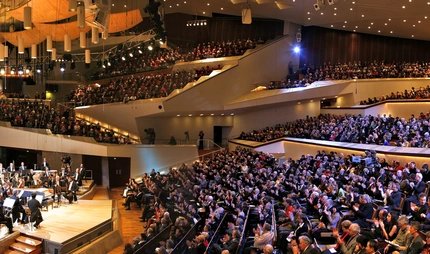
ICC - Internationales Congress Centrum Berlin
High-tech architecture from the 1970s
The gigantic building, Germany's most important congress centre until 2014, is reminiscent of a spaceship with its more than 300-metre-long aluminium façade.

The ICC was built in the high-tech architectural style that became popular in the 1970s. Its concrete, steel and glass buildings are characterised by an aesthetic style that reveals the function of the building parts.

International clout: In the beginning there is the desire for greatness
West Berlin, 1970: the Congress Hall in Tiergarten, the so-called pregnant oyster, finally became too small. It could only accommodate a maximum of 1,200 people, which meant West Berlin was no longer able to keep up as an international congress location.
In 1966, AMK (Ausstellungs-, Messe-, Kongress-GmbH) held a competition to design a multi-purpose hall with a capacity for approx. 4,000 people. The winning design came from a young, still unknown husband-and-wife architect team: Ralf Schüler and Ursulina Schüler-Witte.
Prior to being carried out it became clear that a mere multi-purpose hall was not a solution for the future challenges. At the end of the 1960s, tourism experts predicted a steady increase in the number of congresses, which were a profitable source of income. West Berlin wanted to redefine itself as a congress city and needed an appropriate conference centre.
In the end it turned into a mammoth project. The construction costs amounted to almost one billion marks. In 1979, the ICC thus replaced the State Library, which had just opened a year earlier, as the most expensive new building in West Berlin.
Parallel to the ICC, the Palace of the Republic was being built in East Berlin, a prestigious GDR building that needed to be countered. The ICC was intended to symbolise the superiority of the social market economy and contribute to boosting the economy of West Berlin, which was still isolated at the time.
Spaceship launch
Ralf Schüler and Ursulina Schüler-Witte were commissioned to build the conference centre. They designed an enormous building: 313 metres long, 89 metres wide, 40 metres high.
Slightly more than 20,000 participants can be accommodated at major events here. It has a total of 80 conference rooms, ranging from seven to 6,000 square metres each. The auditorium can hold up to 5,000 people, and Hall 2 around 4,000 visitors.

The ICC stands out due to its sheer dimensions alone and belongs to the few large buildings built in the high-tech architectural style.
The building also impresses with its machine-like appearance: futuristic, in keeping with the growing enthusiasm for technology in the 1970s. This can be clearly seen in the framework-like construction that runs along the façade. It supports the statics of the conference centre and evokes associations with construction site scaffolding.
The construction work started in 1975, six years after the first moon landing. It was therefore no wonder that the voluminous building with its shape and aluminium façade was called a spaceship. It became a popular postcard motif and landmark of future-oriented West Berlin.
Endowed with retro charm
The ICC had state-of-the-art technology at its opening: 8,000 chairs in the conference rooms were equipped with interpretation equipment for up to eight languages. Participants could talk into a microphone from any seat.
Staircases and foyers impressed with their futuristic elements: geometric Op-Art carpets and an innovative guidance system consisting of red and blue fluorescent tubes. Most of the original interior elements are still preserved today and possess a certain retro charm.

A three-storey bridge leads across the Messedamm to the exhibition grounds. This enables conference and trade fair participants to walk back and forth between the building complexes in comfort.
The design was a complete success. For over 30 years, ICC Berlin was the most important conference centre in Germany. It received many awards in the 1980s and 2000s, such as the World Travel Award.
The end or a new beginning?
Despite its popularity, the technology in the ICC Berlin was getting a bit long in the tooth. The last event took place in 2014. But the ICC was still not completely redundant: the State of Berlin used it as an emergency shelter for refugees from 2015 to 2017, and was commissioned to develop a concept for its continued use.
Our tips for nearby the ICC
Visit the Funkturm Berlin (Radio Tower) with its restaurant and viewing platform (162 metres high) and enjoy the panoramic view across the city. For architecture fans: opposite the ICC and Funkturm you will find the Haus des Rundfunks (Broadcasting House), which was built between 1929 and 1931 according to designs by Hans Poelzig. The RBB offers historical/architectural guided tours where you can learn about the history of radio.
Practical information from visitBerlin
The best way to get to the ICC from the city centre is to take the S-Bahn to Westkreuz station or line U2 to Kaiserdamm U-Bahn station. To explore the city by public transport, we recommend the Berlin WelcomeCard.


